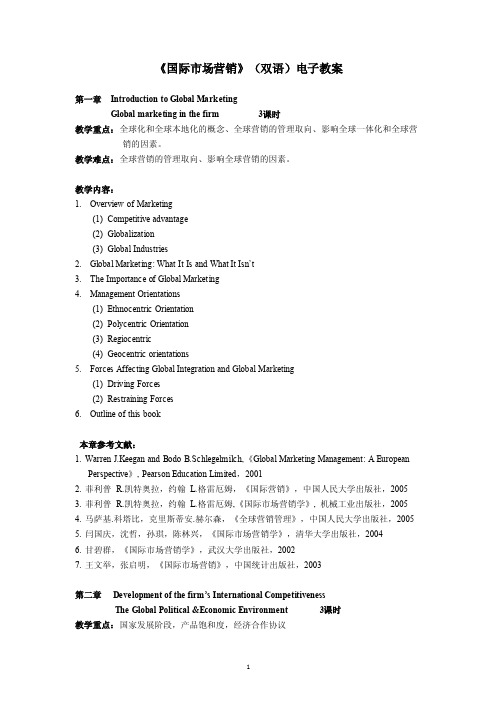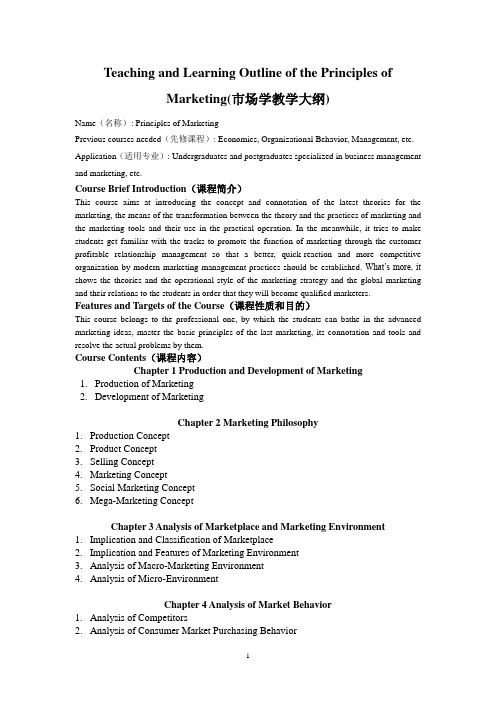市场营销外文翻译教学教材
国际市场营销双语教学教案10-PPT精品.ppt

5. Strategies Overcoming the Price Escalation
(1) Reorganize the channel of distribution;
(2) Adapt the product; (3) Use new or more economical tariff or tax classifications; (4) Assemble or produce overseas
边际成本 2.00 0.00 0.10 0.00 2.10 0.00 0.00 1.00 1.25 4.35 1.09 5.44
5
4. Export-Related Costs
(1) The cost of modifying the product for foreign markets; (2)Operational costs of the export operation: personnel, market research, additional shipping and insurance costs, communications costs with foreign customers, and overseas promotional costs; (3) Costs incurred in entering the foreign markets; tariffs and taxes; risks associated with a buyer in a different market; and risks from dealing in other than the exporter’s domestic currency, i.e., foreign exchange risk.
市场营销国外原版教材第一章

Malhotra, Hall, Shaw, Oppenheim: Marketing Research 3e © 2006 Pearson Education Australia
5
Topic
▪ What is marketing research? ▪ History of marketing research ▪ Research for management decision
problem ▪ Careers in marketing research ▪ Marketing research process ▪ Defining the management decision
problem ▪ International marketing research ▪ Summary
Malhotra, Hall, Shaw, Oppenheim: Marketing Research 3e © 2006 Pearson Education Australia
6
What is Marketing Research?
▪ Information and knowledge about the market environment are vital
4
Chapter Outline
▪ What is marketing research? ▪ History of marketing research ▪ Research for management decision making ▪ Careers in marketing research ▪ Marketing research process ▪ Defining the management decision problem ▪ International marketing research ▪ Summary
市场营销专业外语教程课本翻译【3~6页】

【这是从第3页翻译到第6页】一些最成功的商业组织今天来到这里是因为许多年前他们提供正确的产品在正确的时间,一个快速增长的市场,有些也可以被称为非营利组织和政府过去的重要决策,过去的许多关键的决定是没有战略思维和规划的效益,这些决定是基于智慧或只是运气是不重要的,他们为这些组织工作然而,一个更糟糕的命运发生了无数的其他四分之三的美国100家最大的公司70年前从这些公司在同一时间市场下跌,控制庞大的资源,并有训练有素的工人。
最后,他们都犯了同样严重的错误,他们的管理人员没有认识到,商业策略必须反映不断变化的环境中,必须把重点放在开发的业务系统,允许持续改进。
相反,他们试图继续照常营业。
今天的管理者越来越认识到智慧和创新就不再足以引导组织的命运,大和小的。
这些相同的管理者也意识到该组织的真正使命是提供有价值的关键选区:客户,员工,和投资者,没有这种前景,没有人,包括股东,将利润从长远角度来看。
战略规划包括了所有为满足自身需要的产物,引导组织目标的发展的组织使命和合适整个企业目标实现策略。
过程本身的形式已经在一些过于结构化的地方被批评。
然而,战略规划,如果成功执行,通过平衡可接受的财务绩效与市场,不可避免的变化和竞争的制备技术,实现短期和长期之间的平衡起着关键的作用,以及在经济和政治领域。
管理主要是对目前的现金流,市场份额和收入趋势,公司的未来可以抵押贷款。
在近期的焦点可以使商业停滞,产生一种可恶风险。
相反,在长期的过分强调,是不恰当的。
公司过分扩张自己赌未来可能判处短期盈利和经营结果使得公司面临收购和其他威胁的行动的程度。
在图1.2描绘的是战略规划的过程。
在战略规划过程中收集组织关于其环境改变的元素的信息。
经理从组织中的所有职能领域帮助这个信息收集过程。
通过战略规划的过程,这个信息是有用的帮助组织更好地适应这些变化。
战略计划和支持计划,是在环境中实现的。
这个最终结果反馈为新的信息,是在不断调整和改进中可以发生。
《国际市场营销》(双语)电子教案

《国际市场营销》(双语)电子教案第一章Introduction to Global MarketingGlobal marketing in the firm 3课时教学重点:全球化和全球本地化的概念、全球营销的管理取向、影响全球一体化和全球营销的因素。
教学难点:全球营销的管理取向、影响全球营销的因素。
教学内容:1.Overview of Marketing(1)Competitive advantage(2)Globalization(3)Global Industries2.Global Marketing: What It Is and What It Isn’t3.The Importance of Global Marketing4.Management Orientations(1)Ethnocentric Orientation(2)Polycentric Orientation(3)Regiocentric(4)Geocentric orientations5.Forces Affecting Global Integration and Global Marketing(1)Driving Forces(2)Restraining Forces6.Outline of this book本章参考文献:1.Warren J.Keegan and Bodo B.Schlegelmilch,《Global Marketing Management: A EuropeanPerspective》, Pearson Education Limited,20012.菲利普R.凯特奥拉,约翰L.格雷厄姆,《国际营销》,中国人民大学出版社,20053.菲利普R.凯特奥拉,约翰L.格雷厄姆,《国际市场营销学》, 机械工业出版社,20054.马萨基.科塔比,克里斯蒂安.赫尔森,《全球营销管理》,中国人民大学出版社,20055.闫国庆,沈哲,孙琪,陈林兴,《国际市场营销学》,清华大学出版社,20046.甘碧群,《国际市场营销学》,武汉大学出版社,20027.王文举,张启明,《国际市场营销》,中国统计出版社,2003第二章Development of the firm’s International CompetitivenessThe Global Political &Economic Environment 3课时教学重点:国家发展阶段,产品饱和度,经济合作协议教学难点:国家发展阶段,国际结算,国际金融教学内容:1.The world Economy: An overview2.Economic systems(1)Market Capitalism(2)Centrally Planned Socialism(3)Centrally Planned Capitalism and Market Socialism3.Stages of Market Development(1)Low-Income Countries(2)Lower-Middle-Income Countries(3)Upper-Middle-Income Countries(4)Marketing Opportunities in LDCs and Developing Countries(5)High-Income Countries(6)The Triad(7)Marketing Implications of the stages of Development4.Banlance of Payments5.World Trade in Merchandise and Services6.Overview of International Finance(1)Managed Dirty Float(2)Foreign Exchange Market Dynamics(3)Purchasing Power Parity(4)Economic Exposure(5)Managing Exchange Rate Exposure本章参考文献:1.Warren J.Keegan and Bodo B.Schlegelmilch,《Global Marketing Management: A EuropeanPerspective》, Pearson Education Limited,20012.菲利普R.凯特奥拉,约翰L.格雷厄姆,《国际营销》,中国人民大学出版社,20053.菲利普R.凯特奥拉,约翰L.格雷厄姆,《国际市场营销学》, 机械工业出版社,20054.马萨基.科塔比,克里斯蒂安.赫尔森,《全球营销管理》,中国人民大学出版社,20055.闫国庆,沈哲,孙琪,陈林兴,《国际市场营销学》,清华大学出版社,20046.甘碧群,《国际市场营销学》,武汉大学出版社,20027.王文举,张启明,《国际市场营销》,中国统计出版社,2003年第三章Social and Cultural Environments 3课时教学重点:高背景文化和低背景文化、马斯洛的需求层次说、霍夫斯泰德德文化类型说以及自参考标准教学难点:霍夫斯泰德文化类型说、自参考标准和文化差异和相似性教学内容:1.High- and Low-Context Cultures2.Hofstede’s Cultural Typology3.The Self-Reference Criterion and Perception4.Diffusion Theory+(1)The Adoption Process(2)Characteristics of Innovations(3)Adopter Categories(4)Diffusion of Innovations in Pacific Rim Countries5.Marketing Implications of Social and Cultural Environments本章参考文献:1.Warren J.Keegan and Bodo B.Schlegelmilch,《Global Marketing Management: A EuropeanPerspective》, Pearson Education Limited,20012.菲利普R.凯特奥拉,约翰L.格雷厄姆,《国际营销》,中国人民大学出版社,20053.菲利普R.凯特奥拉,约翰L.格雷厄姆,《国际市场营销学》, 机械工业出版社,20054.马萨基.科塔比,克里斯蒂安.赫尔森,《全球营销管理》,中国人民大学出版社,20055.闫国庆,沈哲,孙琪,陈林兴,《国际市场营销学》,清华大学出版社,20046.甘碧群,《国际市场营销学》,武汉大学出版社,20027.王文举,张启明,《国际市场营销》,中国统计出版社,2003第四章The Legal and Regulatory Environments of Global Marketing 2课时教学重点:普通法和成文法、专利和商标、许可贸易、法庭裁决和仲裁方式、管理环境教学难点:专利和商标、许可贸易、各种政府和民间组织教学内容1.The Legal Environment(1)Common Law Versus Civil Law(2)Sidestepping Legal Problems: Important Business Issues(3)Conflict Resolution, Dispute Settlement, and Litigation2.The Regulatory Environment(1)Regional Economic Organizations: The European Union Example本章参考文献:1.Warren J.Keegan and Bodo B.Schlegelmilch,《Global Marketing Management: A EuropeanPerspective》, Pearson Education Limited,20012.沈钺,《全球营销学》,武汉大学出版社,20043.菲利普R.凯特奥拉,约翰L.格雷厄姆,《国际市场营销学》, 机械工业出版社,20054.马萨基.科塔比,克里斯蒂安.赫尔森,《全球营销管理》,中国人民大学出版社,20055.闫国庆,沈哲,孙琪,陈林兴,《国际市场营销学》,清华大学出版社,2004年6.甘碧群,《国际市场营销学》,武汉大学出版社,20027.王文举,张启明,《国际市场营销》,中国统计出版社,2003第五章Global Information Systems and Market Research 3课时教学重点:市场信息的来源、正式的市场调查研究步骤教学难点:市场调查研究步骤,一体化的市场信息收集教学内容:rmation Technology for Global Marketingrmation subject agenda and environmental scanning modes3.Sources of market information4.Formal market research(1)Step1: Identify the Information Requirement(2)Step2: Problem Definition---Overcoming the SRC(3)Step3: Choose Unit of Analysis(4)Step4: Examine Data Availability(5)Step5: Assess Value of Research(6)Step6: Research Design(7)Step7: Analyzing Data(8)Step8: Presenting the Findings(9)Headquarter’s Control of Marketing Research(10)A n Integrated Approach to Information Collection本章参考文献:1.Warren J.Keegan and Bodo B.Schlegelmilch,《Global Marketing Management: A EuropeanPerspective》, Pearson Education Limited,20012.沈钺,《全球营销学》,武汉大学出版社,20043.菲利普R.凯特奥拉,约翰L.格雷厄姆,《国际市场营销学》, 机械工业出版社,20054.马萨基.科塔比,克里斯蒂安.赫尔森,《全球营销管理》,中国人民大学出版社,20055.闫国庆,沈哲,孙琪,陈林兴,《国际市场营销学》,清华大学出版社,2004年6.甘碧群,《国际市场营销学》,武汉大学出版社,20027.王文举,张启明,《国际市场营销》,中国统计出版社,20038.王海忠,《全球营销:规则、指南、案例》,企业管理出版社,2002第六章Segmentation, Targeting, and Positioning 4课时教学重点:全球细分、选择目标市场、全球定位、产品市场决策、高科技和高感性定位教学难点:选择目标市场及定位、高科技和高感性定位教学内容:1.Global Market Segmentation(1)Demographic Segmentation(2)Psychographic Segmentation(3)Behavior Segmentation(4)Benefit Segmentation(5)Ethnic Segmentation2.Assessing Market Potential and Choosing Target Markets or Segments(1)Current Segment Size and Growth Potential(2)Potential Competition(3)Feasibility and Compatibility(4)A Framework for selecting Target Markets3.Product-Market Decisions4.Target Market Strategy Options(1)Standardized Global Marketing(2)Concentrated Global Marketing(3)Differentiated Global Marketing5.Positioning(1)Attribute or benefit(2)Quality and Price(3)Use or User(4)Competitor(5)Global, Foreign, and Local Consumer Culture Positioning本章参考文献:1.Warren J.Keegan and Bodo B.Schlegelmilch,《Global Marketing Management: A EuropeanPerspective》, Pearson Education Limited,20012.沈钺,《全球营销学》,武汉大学出版社,20043.菲利普R.凯特奥拉,约翰L.格雷厄姆,《国际市场营销学》, 机械工业出版社,20054.马萨基.科塔比,克里斯蒂安.赫尔森,《全球营销管理》,中国人民大学出版社,20055.闫国庆,沈哲,孙琪,陈林兴,《国际市场营销学》,清华大学出版社,2004年6.甘碧群,《国际市场营销学》,武汉大学出版社,20027.王文举,张启明,《国际市场营销》,中国统计出版社,20038.王海忠,《全球营销:规则、指南、案例》,企业管理出版社,2002第七章Some approaches to the choice of entry modeGlobal Market Entry Strategies: Licensing, Investment, and Strategic Alliances 6课时教学重点:许可和合营、市场扩张战略、投资扩张和战略联盟教学难点:全球战略合作伙伴概念、市场扩张战略教学内容:1.LicensingSpecial Licensing Arrangements2.Investment(1)Joint Ventures(2)Investment via Ownership or Equity Stake3.Global Strategic Partnerships4.The Nature of Global Strategic Partnerships(1)Success Factors(2)Alliances with Asian Competitors(3)CFM International, GE, and Snecma: A Successful Story(4)AT&T and Olivertti: A Failure(5)Boeing and Japan: A Failure(6)International Partnerships in Developing Countries5.Cooperative Strategies in Japan: Keiretsu6.Cooperative Strategies in South Korea: Chaebol7.Twenty-First Century Cooperative Strategies: Targeting the Digital Future8.Market Expansion Strategies本章参考文献:1.Warren J.Keegan and Bodo B.Schlegelmilch,《Global Marketing Management: A EuropeanPerspective》, Pearson Education Limited,20012.沈钺,《全球营销学》,武汉大学出版社,20043.菲利普R.凯特奥拉,约翰L.格雷厄姆,《国际市场营销学》, 机械工业出版社,20054.马萨基.科塔比,克里斯蒂安.赫尔森,《全球营销管理》,中国人民大学出版社,20055.闫国庆,沈哲,孙琪,陈林兴,《国际市场营销学》,清华大学出版社,2004年6.甘碧群,《国际市场营销学》,武汉大学出版社,20027.王文举,张启明,《国际市场营销》,中国统计出版社,20038.王海忠,《全球营销:规则、指南、案例》,企业管理出版社,20029.吴声功,《跨国公司经营管理》,上海人民出版社,2003第八章Product and Brand Decisions 4课时教学重点:产品和品牌概念、原产国因素、地域扩张、全球营销中的新产品开发教学难点:地域扩张、全球营销中的新产品开发教学内容:1.Basic product and brand concepts(1)Product Types(2)Brands(3)Local Products and Brands(4)International Products and Brands(5)Global Products and Brands(6)Global Brand Development(7)Local Versus Global Products and Brands: A Need-Based Approach2.Country of origin as brand element3.Packaging(1)Labeling(2)Aesthetics4.Product warranties5.Extend, Adapt, Great: strategic alternatives in global marketing(1)Strategy1: Product-Communication Extension(2)Strategy2: Product Extension-Communication Adaptation(3)Strategy3: Product Adaptation-Communication Extension(4)Strategy4: Product-Communication Adaptation(5)Strategy5: Product Invention(6)How to Choose a strategy6.New products in global marketing(1)Identifying New-Product Ideas(2)New-Product Development(3)The International New-Product Department(4)Testing New Products本章参考文献:1.Warren J.Keegan and Bodo B.Schlegelmilch,《Global Marketing Management: A EuropeanPerspective》, Pearson Education Limited,20012.沈钺,《全球营销学》,武汉大学出版社,20043.菲利普R.凯特奥拉,约翰L.格雷厄姆,《国际市场营销学》, 机械工业出版社,20054.马萨基.科塔比,克里斯蒂安.赫尔森,《全球营销管理》,中国人民大学出版社,20055.闫国庆,沈哲,孙琪,陈林兴,《国际市场营销学》,清华大学出版社,2004年6.甘碧群,《国际市场营销学》,武汉大学出版社,20027.杨建新,《产品生命周期评价方法及应用》,气象出版社,20028.胡树华,《产品开发设计的功能成本分析》,科学出版社,20019.李倩茹,《新产品开发、定位和销售》,广州经济出版社,2002第九章Pricing Decisions 4课时教学重点:全球定价目标和策略、影响定价决策的环境因素、灰色市场、倾销、转移定价、反向贸易教学难点:全球定价策略、灰色市场、倾销、抵销、反向贸易教学内容:1.Basic pricing concepts2.Global pricing objectives and strategies(1)Market Skimming and Financ ial Objectives(2)Penetration Pricing and Nonfinancial Objectives(3)Companion Product “Razors and Blades” Pricing(4)Target Costing(5)Calculating Prices: Cost-based Pricing and Price Escalation(6)Terms of Sale3.Environment influences on pricing decisions(1)Currency Fluctuations(2)Inflationary Environment(3)Government Controls, Subsidies, and Regulations(4)Competitive Behavior(5)Using Sourcing as a Strategic Pricing Tool4.Global pricing: three policy alternatives(1)Extension or Ethnocentric(2)Adaptation or Polycentric(3)Geocentric5.Gray market goods6.Dumping7.Price fixing8.Transfer pricing(1)Tax Regulations and Transfer Prices(2)Sales of Tangible and Intangible Property(3)Competitive Pricing(4)Importance of Section 482 Regulations9.Countertrade(1)Barter(2)Counterpurchase(3)Offset(4)Compensation Trading(5)Switch Trading本章参考文献:1.Warren J.Keegan and Bodo B.Schlegelmilch,《Global Marketing Management: A EuropeanPerspective》, Pearson Education Limited,20012.沈钺,《全球营销学》,武汉大学出版社,20043.菲利普R.凯特奥拉,约翰L.格雷厄姆,《国际市场营销学》, 机械工业出版社,20054.马萨基.科塔比,克里斯蒂安.赫尔森,《全球营销管理》,中国人民大学出版社,20055.闫国庆,沈哲,孙琪,陈林兴,《国际市场营销学》,清华大学出版社,2004年6.甘碧群,《国际市场营销学》,武汉大学出版社,20027.王文举,张启明,《国际市场营销》,中国统计出版社,20038.王海忠,《全球营销:规则、指南、案例》,企业管理出版社,20029.吴声功,《跨国公司经营管理》,上海人民出版社,2003第十章Global Marketing Channels and Physical Distribution 4课时教学重点:分销渠道管理、建立和保持渠道中介、全球零售业、物流管理教学难点:全球零售渠道、物流管理教学内容:1.Channel objectives2.Distribution channels :terminology and structure(1)Consumer Products and Services(2)Industrial Products3.Establishing channels and working with channel intermediaries4.Global retailing5.Innovation in global retailing6.Physical distribution, supply chains, and logistics management(1)Order Processing(2)Warehousing(3)Inventory Management(4)Transportation(5)Logistics Management: A Brief Case Study本章参考文献:1.Warren J.Keegan and Bodo B.Schlegelmilch,《Global Marketing Management: A EuropeanPerspective》, Pearson Education Limited,20012.沈钺,《全球营销学》,武汉大学出版社,20043.菲利普R.凯特奥拉,约翰L.格雷厄姆,《国际市场营销学》, 机械工业出版社,20054.马萨基.科塔比,克里斯蒂安.赫尔森,《全球营销管理》,中国人民大学出版社,20055.闫国庆,沈哲,孙琪,陈林兴,《国际市场营销学》,清华大学出版社,2004年6.甘碧群,《国际市场营销学》,武汉大学出版社,20027.李飞,《分销渠道》,清华大学出版社,20038.邹树彬,《分销渠道管理》,广东经济出版社,2000第十一章Global Marketing Communications Decisions:Advertising and Public Relations 4课时教学重点:全球广告、全球媒体决策、公共关系和公众度教学难点:全球广告、世界各地的公关差异教学内容:1.Global advertisingGlobal Advertising Content: The “Standardization” versus “adaptation” Debate2.Advertising agency: organizations and brandsSelecting an Advertising Agency3.Creating global advertising(1)Art Directors and Art Direction(2)Copy(3)Cultural Considerations4.Global media decisions(1)Media vehic les and expenditures(2)Media Decisions5.Public relations and publicity(1)The Growing Role of Public Relations in Global Marketing(2)Communications(3)How public relations practices differ around the world本章参考文献:1.Warren J.Keegan and Bodo B.Schlegelmilch,《Global Marketing Management: A EuropeanPerspective》, Pearson Education Limited,20012.沈钺,《全球营销学》,武汉大学出版社,20043.菲利普R.凯特奥拉,约翰L.格雷厄姆,《国际市场营销学》, 机械工业出版社,20054.马萨基.科塔比,克里斯蒂安.赫尔森,《全球营销管理》,中国人民大学出版社,20055.闫国庆,沈哲,孙琪,陈林兴,《国际市场营销学》,清华大学出版社,2004年6.甘碧群,《国际市场营销学》,武汉大学出版社,20027.王文举,张启明,《国际市场营销》,中国统计出版社,20038.王海忠,《全球营销:规则、指南、案例》,企业管理出版社,20029.吴声功,《跨国公司经营管理》,上海人民出版社,200310.张映红,《公共关系管理》,北京经济学院出版社,200311.周广华,《促销管理实战》,广东经济出版社,2003第十二章Strategic Elements of Competitive Advantage 3课时教学重点:行业分析(影响竞争的因素)、竞争优势、全球竞争和国家竞争优势教学难点:竞争优势、全球竞争和国家竞争优势教学内容:1.Industry analysis: forces influencing competition(1)Threat of New Entrants(2)Threat of Substitute Products(3)Bargaining Power of Buyers(4)Bargaining Power of Supplier(5)Rivalry Among Competitorspetitive advantage(1)Generic Strategies for Creating Competitive Advantage(2)The Flagship Firm: The Business Network with Five Partners(3)Creating Competitive Advantage via Strategic Intent3.Global competition and national competitive advantage(1)Demand Conditions(2)Related and Supporting Industries(3)Firm Strategy, Structure, and Rivalry(4)Chance(5)Government4.Current issues in competitive advantage本章参考文献:1.Warren J.Keegan and Bodo B.Schlegelmilch,《Global Marketing Management: A EuropeanPerspective》, Pearson Education Limited,20012.沈钺,《全球营销学》,武汉大学出版社,20043.菲利普R.凯特奥拉,约翰L.格雷厄姆,《国际市场营销学》, 机械工业出版社,20054.马萨基.科塔比,克里斯蒂安.赫尔森,《全球营销管理》,中国人民大学出版社,20055.闫国庆,沈哲,孙琪,陈林兴,《国际市场营销学》,清华大学出版社,2004年6.甘碧群,《国际市场营销学》,武汉大学出版社,20027.王文举,张启明,《国际市场营销》,中国统计出版社,20038.王海忠,《全球营销:规则、指南、案例》,企业管理出版社,20029.吴声功,《跨国公司经营管理》,上海人民出版社,2003第十三章The Digital Revolution and Global Electronic Marketplace 3课时教学重点:行业集中、价值网络和分裂性科技、全球电子营销、移动商业和无线连接教学难点:行业集中、价值网络、全球电子营销教学内容:1.The digital revolution: a brief history2.Convergence3.Value-Networks and disruptive technologies4.Global E-Commerce5.Web site design6.New product and servicesBroadband7.Mobile commerce and wireless connectivity(1)Smart Cell Phones(2)Internet Phone Service8.Conclusion本章参考文献:1.Warren J.Keegan and Bodo B.Schlegelmilch,《Global Marketing Management: A EuropeanPerspective》, Pearson Education Limited,20012.沈钺,《全球营销学》,武汉大学出版社,20043.菲利普R.凯特奥拉,约翰L.格雷厄姆,《国际市场营销学》, 机械工业出版社,20054.马萨基.科塔比,克里斯蒂安.赫尔森,《全球营销管理》,中国人民大学出版社,20055.闫国庆,沈哲,孙琪,陈林兴,《国际市场营销学》,清华大学出版社,2004年6.甘碧群,《国际市场营销学》,武汉大学出版社,20027.王文举,张启明,《国际市场营销》,中国统计出版社,20038.王海忠,《全球营销:规则、指南、案例》,企业管理出版社,20029.吴声功,《跨国公司经营管理》,上海人民出版社,200310.怀特,董俊英,《国际营销错误案例》,北京经济科学出版社,2003第十四章Overall review of course and Preparation of final exam 2课时教学内容:回顾本学期所学内容,梳理各章节知识要点,准备期末考试。
课件市场营销原理英文原版

Designing a Customer-Driven Marketing Strategy
Marketing Management Orientations
Societal marketing concept is the idea that a company should make good marketing decisions by considering consumers’ wants, the company’s requirements, consumers’ long-term interests, and society’s long-run interests
Production concept is the idea that consumers will favor products that are available or highly affordable
Designing a Customer-Driven Marketing Strategy
Customer Relationship Management (CRM)
• The overall process of building and maintaining profitable customer relationships by delivering superior customer value and satisfaction
Building Customer Relationships
Relationship Building Blocks: Customer Value and Satisfaction
Building Customer Relationships
市场营销教学大纲双语

Teaching and Learning Outline of the Principles ofMarketing(市场学教学大纲)Name(名称): Principles of MarketingPrevious courses needed(先修课程): Economics, Organizational Behavior, Management, etc. Application(适用专业): Undergraduates and postgraduates specialized in business management and marketing, etc.Course Brief Introduction(课程简介)This course aims at introducing the concept and connotation of the latest theories for the marketing, the means of the transformation between the theory and the practices of marketing and the marketing tools and their use in the practical operation. In the meanwhile, it tries to make students get familiar with the tracks to promote the function of marketing through the customer profitable relationship management so that a better, quick-reaction and more competitive organization by modern marketing management practices should be established. What’s more, it shows the theories and the operational style of the marketing strategy and the global marketing and their relations to the students in order that they will become qualified marketers.Features and Targets of the Course(课程性质和目的)This course belongs to the professional one, by which the students can bathe in the advanced marketing ideas, master the basic principles of the last marketing, its connotation and tools and resolve the actual problems by them.Course Contents(课程内容)Chapter 1 Production and Development of Marketing1.Production of Marketing2.Development of MarketingChapter 2 Marketing Philosophy1.Production Concept2.Product Concept3.Selling Concept4.Marketing Concept5.Social Marketing Concept6.Mega-Marketing ConceptChapter 3 Analysis of Marketplace and Marketing Environment1.Implication and Classification of Marketplace2.Implication and Features of Marketing Environment3.Analysis of Macro-Marketing Environment4.Analysis of Micro-EnvironmentChapter 4 Analysis of Market Behavior1.Analysis of Competitors2.Analysis of Consumer Market Purchasing Behavior3.Purchasing Behavior Analysis of Organizational MarketChapter 5 Market Segmentation, Targeting and Positioning1.Market Segmentation2.Market Targeting3.Market PositioningChapter 6 Marketing Strategies1.Generalities2.Business Determination Adapt to the Marketing Strategy3.Varieties of the Marketing StrategyChapter 7 Marketing Competitive Strategies1. Five Basic Competitive Forces2.Basic Competitive Strategiespetitor Ranking and Marketing Competitive StrategyChapter 8 Marketing Engineering1.Origin and Development of the Marketing Engineering2.Connotation and Elements of the Marketing Engineering3.Marketing Engineering MethodsChapter 9 Marketing Investigation and Market Forecast1. Marketing Information Systems2.Marketing Research3.Marketing ForecastingChapter 10 Product Strategie1. Generalities2.Product Policies3.Product Positioning4.Product Strategies5.BrandsChapter 11 Price Strategies1. Factors Affecting Pricing2.Elementary Pricing Methods3.Basic Pricing StrategyChapter 12 Place Strategies1.Basic Types and Features of Place2.Choice Tactics of Place3.Wholesalers and RetailorsChapter 13 Promotional Strategies1.Generalities2.Sales Promotion3.Public Relation4.AdvertisingChapter 14 Marketing Management1.Marketing Planning2.Marketing Organization3.Marketing Control4.Marketing AuditChapter 15 Other Marketing Orientations1.Service Marketing2.Experiential Marketing3.International Marketing4.Social MarketingTeaching Materials and Reference[1] Philip Kotler, Gary Armstrong.Principles of Marketing, Eleventh Edition, 清华大学出版社, October, 2007[2] 梁东、刘建堤、孙安彬、谭学英等,《市场营销学》,清华大学出版社, 2007年6月。
市场营销 (双语教材)Chapter Two Marketing Philosophy

2.1 Production Concept
2.1.1 Background of Production Concept
The production concept stemmed from the late 19th century to 1920s. In this stage, the capitalist production was still at a relatively low level because of the shortage of materials after experiencing the World War II, and their products could not fully meet the market demand. In the seller’s market conditions, the market demand can only passively submit to the production. What the consumers care about is whether they can buy goods, the price is cheap or not and the main features of products without paying attention to some small differences of products. Therefore enterprises will be able to profit from a large number of production and sales by delivering a single line of products in the market.
双语示范课程《国际市场营销》教学

双语示范课程《国际市场营销》教学《国际市场营销学》International Marketing(双语)教学大纲学分/总学时:3/54一,课程的性质,目的和任务."国际市场营销学"(International Marketing)是市场营销专业的专业必修课.采用双语教学,使用英语原版教材,并结合课程内容,组织学生以小组的形式开展研究,制定针对相关国家的国际市场营销计划,并将研究成果在课堂上作演说汇报.本课程的教学目的是使学生能较为系统地理解和掌握国际市场营销的基本理论和实践.课程的主要内容包括国际营销的范围和挑战,国际营销的全球环境,全球市场评估中的文化因素,国际营销调研,全球营销管理,国际营销渠道,国际广告及国际市场定价.本课程在教学中坚持理论分析与实例,案例分析相结合的方法,为学生提供大量的案例陈述,分析和讨论的机会,锻炼和培养学生分析问题和解决问题的能力.课程全部章节均使用英语授课.课件全部用英语.要求学生尽量用英语参与课堂讨论,完成作业.试卷的出题全部使用英语.通过双语教学,培养学生用英语获取和交流专业知识的水平和能力.二,学习本课程学生应掌握的前设课程知识经济学,管理学原理,市场营销学,英语综合运用知识和能力三,学时分配1. The Scope and Challenge of International Marketing(国际营销的范围和挑战)(4学时)2. The Global Environment of International Marketing (国际营销的全球环境)(4学时)3. History and Geography: The Foundations of Culture(历史与地理–文化的基础) (3学时)4. Cultural Dynamics in Assessing Global Markets(全球市场评估中的文化因素)(3学时)5. Culture, Management Style, and Business Systems(文化,管理风格与经营方式) (3学时)6. The Political Environment(政治环境) (3学时)7. The International Legal Environment(国际法律环境) (4学时)8. Developing a Global Vision through Marketing Research(通过营销调研建立全球视野) (4学时)9. Global Marketing Management: Planning and Organization(全球营销管理–计划和组织) (4学时)10. Products and Services for Consumers(面向消费者的产品和服务) (4学时)11. International Marketing Channels(国际营销渠道) (4学时)12. Integrated Marketing Communications and International Advertising(一体化的营销沟通与国际广告) (4学时)13. Personal Selling and Sales Management(人员推销与销售管理) (4学时)14. Pricing for International Markets(国际市场定价) (4学时)15. Review(2学时)四,课程基本要求和内容Part One: An OverviewChapter1:The Scope and Challenge of International Marketing(国际营销的范围和挑战)4学时Learning Objectives(基本要求):T o learn and understand the followings: the scope of the international marketing task; the importance of the cross-cultural analysis in international marketing; the progression of becominga global marketer; the increasing importance of global awareness.1. International Marketing Defined2. The International Marketing Task3. Environmental Adaptation Needed4. The Self-Reference Criterion and Ethnocentrism5. Developing a Global Awareness6. Stages of International Marketing Involvement7. Strategic Orientation8. The Orientation of International MarketingChapter2:The Global Environment of International Marketing (国际营销的全球环境)4学时Learning Objectives(基本要求):To learn and understand the followings: the importance of GA TT and the World Trade Organization; the emergence of the International Monetary Fund and the World Bank Group; the evolution of the European Community to the European Union; the trade linkage of NAFTA and South America and its regional effects; the development of trade within the Asia-Pacific Rim; the growth of developing markets and their importance to regional trade.1. GATT and WTO2. The International Monetary Fund and World Bank Group3. Protests against Global Institutions4. Global Markets and Multinational Market Groups5. Marketing in a Developing CountryPart Two: The Cultural Environment of Global MarketsChapter3: History and Geography: The Foundations of Culture(历史与地理–文化的基础)3学时Learning Objectives(基本要求):To learn and understand the following: the importance of history and geography in the understanding of international markets; the effects of history on a country's culture; effect of geographic diversity on economic profiles of a country; economic effects of controlling population growth versus aging population.1. Historical Perspective in Global Business2. Geography and Global Markets3. Dynamics of Global Population Trends4. World Trade RoutesChapter4: Cultural Dynamics in Assessing Global Markets(全球市场评估中的文化因素)3学时Learning Objectives(基本要求):To learn and understand the following: the importance of culture to an international marketer; the origins and elements of culture; the impact of cultural borrowing;the strategy of planned change and its consequences.1. Culture's Pervasive Impact2. Definitions and Origins of Culture3. Elements of Culture4. Cultural Knowledge5. Cultural ChangeChapter5: Culture, Management Style, and Business Systems(文化,管理风格与经营方式)4学时Learning Objectives(基本要求):To learn and understand the following: the necessity for adapting to cultural differences; how and why management styles vary around the world; the extent and implications of gender bias in some countries; the importance of cultural differences in business ethics; the differences between relationship-oriented and information-oriented cultures.1. Required Adaptation2. Management Styles around the World3. Gender Bias in International Business4. Business Ethics5. Culture's Influence on Strategic Thinking6. A Synthesis, Relationship-Oriented versus Information-Oriented CulturesChapter6: The Political Environment: A Critical Concern (政治环境)4学时Learning Objectives(基本要求):To learn and understand the following: what the sovereignty of nations means and how it affects the stability of government policies, political parties, and nationalism; the political risks of global business and the factors that affect stability; the importance of the political system to international marketing and its effects on foreign investments; assessing and reducing the effects of political vulnerability.1. The Sovereignty of Nations2. Stability of Government Policies3. Political Risks of Global Business4. Assessing Political Vulnerability5. Reducing Political VulnerabilityChapter7: The International Legal Environment(国际法律环境)4学时Learning Objectives(基本要求):To learn and understand the following: the four heritages of today's legal systems; the important factors in jurisdiction of legal disputes; issues associated with jurisdiction of legal disputes and the various methods of dispute resolution; the unique problemsof protecting intellectual property rights internationally; ways to protect against piracy and counterfeiting; the legal differences between countries and how the differences can affect international marketing plans.1. Bases for Legal Systems2. Jurisdiction in International Legal Disputes3. International Dispute Resolution4. Protection of Intellectual Property Rights5. Commercial Law within CountriesPart three: Developing Global Marketing StrategiesChapter 8: Developing a Global Vision through MarketingResearch(通过营销调研建立全球视野)4学时Learning Objectives(基本要求):To learn and understand the following: the importance of problem definition in international research; the problems of availability and use of secondary data; quantitative and qualitative research methods; sources of secondary data; how to analyze and use research information.1. Breadth and Scope of International Marketing Research2. The Research Process3. Defining the Problem and Establishing Research Objectives4. Problems of Availability and Use of Secondary Data5. Gathering Primary Data: Quantitative and Qualitative Research6. Multicultural Research: A Special Problem7. Research on the Internet: A Growing Opportunity8. Estimating Market Demand9. Problems in Analyzing and Interpreting Research Information10. Responsibility for Conducting Marketing Research11. Communicating with Decision MakersChapter9: Global Marketing Management: Planning and Organization(全球营销管理–计划和组织)4学时Learning Objectives(基本要求):To learn and understand the following: how global marketing management differs from international marketing management; the increasing importance of international strategic alliances; the need for planning to achieve company goals; the important factors for each alternative market-entry strategy.1. Global Marketing Management: An Old Debate and a New View2. Planning for Global Markets3. Alternative Market-Entry Strategy4. Organizing for Global CompetitionChapter10: Products and Services for Consumers(面向消费者的产品和服务)4学时Learning Objectives(基本要求):To learn and understand the following: the importance of offering a product suitable for the intended market; the importance of quality and how quality is defined; country-of-origin effects on product image; physical, mandatory, and cultural requirements for product adaptation; the need to view all attributes of a product in order to overcome resistance to acceptance.1. Quality2. Products and Culture3. Analyzing Product Components for Adaptation4. Marketing Consumer Services Globally5. Brands in International MarketsChapter11: International Marketing Channels(国际营销渠道)4学时Learning Objectives(基本要求):To learn and understand the followings: the variety of distribution channels and how they affect cost and efficiency in marketing; how distribution patterns affect the various aspects of international marketing; the growing importance of e-commerce as a distribution alternative; the functions, advantages, and disadvantages of various kinds of middlemen; the importance of middlemen to a product's success and the importance of selecting and maintaining middlemen.1. Channel-of-Distribution Structures2. Distribution Patterns3. Alternative Middleman Choices4. Factors Affecting Choices of Channels5. Locating, Selecting, and Motivating Channel Members6. The InternetChapter12: Integrated Marketing Communications and International Advertising(一体化的营销沟通与国际广告)4学时Learning Objectives(基本要求):To learn and understand the followings: local market characteristics that affect the advertising and promotion of products; the strengths and weaknesses of sales promotion and public relations in global marketing; when global advertising is most effective; when modified advertising is necessary; the effect of limited media, excessive media, and government regulations on advertising and promotion budgets.1. Sales Promotions in International Markets2. International Public Relations3. International Advertising4. Advertising Strategy and Goals5. The Message: Creative Challenge6. Media Planning and Analysis7. Campaign Execution and Advertising Agency8. International Control of AdvertisingChapter13: Personal Selling and Sales Management(人员推销与销售管理)4学时Learning Objectives(基本要求):To learn and understand the followings: the role of interpersonal selling in international marketing; the considerations in designing an international sales force; the steps to recruiting three types of international sales people; selection criteria for international sales and marketing positions; the special training needs of international personnel; motivation techniques for international sales representatives; how to design compensation systems for an international salesforce; the changing profile of the global sales and marketing manager.1. Designing the Sales Force2. Recruiting Marketing and Sales Personnel3. Selecting Sales and Marketing Personnel4. Training for International Marketing5. Motivating Sales Personnel6. Designing Compensation Systems7. Evaluating and Controlling Sales Representatives8. Developing Cultural Awareness9. The Changing Profile of the Global Manager10. Foreign Language SkillsChapter14: Pricing for International Markets(国际市场定价)4学时Learning Objectives(基本要求):To learn and understand the following: components of pricing as competitive tools in international marketing; the pricing pitfalls directly related to international marketing; how to control pricing in parallel imports or gray markets; price escalation and how to minimize its effect; countertrading and its place in international marketing practices; the mechanisms of price quotations.1. Pricing Policy2. Approaches to International Pricing3. Price Escalation4. Approaches to Lessening Price Escalation5. Leasing in International Markets6. Countertrade as a Pricing Tool7. Transfer Pricing Strategy8. Price Quotation9. Administered PricingPart Four :Supplementary Material五,教材及学生参考书教材:Philip Cateora等著International Marketing(国际营销)12th Edition(第12版) 中国人民大学出版社2005年3月参考书:1,Michael R. Czinkota著International Marketing(国际商务) 8th Edition(第8版) 北京大学出版社2007年10月。
国际市场营销(双语)课程Pampers

• Second, in conjunction with P&G’s research at Beijing Children’s Hospital, they were also studying what parent’s wanted from the product itself. The surprising take-away was that in P&G’s efforts to sell a low-cost version of the product, they ad inadvertently positioned the Pampers product line as not only low-cost, but much more importantly, low quality. New Chinese parents, who wanted something much softer next to their new baby’s skin, rejected the plastic “feel”. P&G initially thought they were rejected for cultural and cost reasons, but they were actually rejected because they did not make enough of an effort to build the narrative around how their product would benefit the child and parents (who both benefit if the baby sleeps more soundly), and because they assumed cost was the primary driver when softness actually was.
国际市场营销双语教程课件 cha4

market segmentation and positioning method should be adopted
• 我国高铁打入国际市场,应该采取哪种细分模式和定位战略?
• (7)What is the STP strategy in international marketing theory?
• 什么是国际市场营销的STP理论?
• (8)What is the definition of the Global Market Segmentation?
• 谈谈全球市场细分的定义
Chapter 4 Global Market Segmentation
• Learning Objectives • 本章学习目标
• 1. Understand the Meaning of the International Market Segmentation.
• 了解国际市场细分的意义 • 2. Identify the Necessary Conditions for Effective International
be ed?
• 在考虑消费者行为结构时,需要分析那些变量因素?
• (5)List some examples for global market segmentation by using the geographic factors.
•
举例说明使用地理因素进行全球市场细分的例子。
• (6) For China’s High Speed Railway System entering overseas market, what types of
•
在实施市场细分时需要考虑哪些因素?
• (3) Describe how to apply market segmentation to the global market
04878_国际市场营销双语教学教案ppt课件

2024/1/26
1
目录
• 课ቤተ መጻሕፍቲ ባይዱ介绍与教学目标
• 国际市场营销基本概念与理论
• 跨文化交流与沟通在国际市场营销中应用
• 产品策略在国际市场营销中实践
• 价格策略在国际市场营销中运用
• 渠道策略在国际市场营销中拓展
• 促销策略在国际市场营销中创新
• 总结回顾与展望未来发展趋势
16
04
产品策略在国际市场营销中 实践
2024/1/26
17
产品定位与差异化战略
产品定位
根据目标市场需求和竞争态势, 明确产品在市场中的定位,包括 产品特点、目标消费者群体、价
格策略等。
2024/1/26
差异化战略
通过独特的产品设计、功能、品质 、服务等方面与竞争对手区分开来 ,形成独特的竞争优势,提高市场 份额和盈利能力。
8
国际市场营销环境分析
01
02
03
04
政治环境
分析目标国家的政治稳定性、 政策连续性、对外关系等因素
。
经济环境
研究目标国家的经济发展水平 、市场规模、消费者购买力等
。
社会文化环境
了解目标国家的文化传统、价 值观念、消费习惯等。
技术环境
关注目标国家的技术发展水平 、创新能力和知识产权保护等
。
2024/1/26
2024/1/26
27
电子商务平台利用和整合
2024/1/26
电子商务平台选择
根据产品特性和目标市场,选择合适的电子商务平台,如亚马逊 、阿里巴巴等。
线上线下融合
将线上电子商务平台与线下实体店相结合,实现O2O模式,提高 消费者购物体验和品牌认知度。
国际市场营销双语教学教案1-

marketplace.
9
5. Group Discussion
(1) What are the recent trends in world trade? Will expansion of world trade in the future follow these trends? (2) Does increased world trade mean increased risk? (3) What impact do global linkages have on firms and consumers? (4) Describe some opportunities and challenges in international marketing created by new advances in informatioore small firms have been becoming the major players in the international business.
(2) Challenges -- Need difference in the different regions and countries. -- More and more complicated market environment. -- More and more intensive competition in the global
市场营销组合 外文翻译课件免费全文阅读

Promotion
• The third P is about promoting your products and services.This may include • advertising, • personal selling sales promotions • Public Relations is also included within Promotion by many marketing people, although PR people tend to see it as a separate discipline.
Product
• The first P is product.This should define the features and rance of goods and services.Here are some examples of the product decisions to be made: • Brand name • Packaging • Warranty • Functionality
place
• The final P is about ‘place ’ – the location where the service is actually go in to be delivered.Many retailers will tell u it"s all about " location, location, locati and this still holds true today.
- 1、下载文档前请自行甄别文档内容的完整性,平台不提供额外的编辑、内容补充、找答案等附加服务。
- 2、"仅部分预览"的文档,不可在线预览部分如存在完整性等问题,可反馈申请退款(可完整预览的文档不适用该条件!)。
- 3、如文档侵犯您的权益,请联系客服反馈,我们会尽快为您处理(人工客服工作时间:9:00-18:30)。
市场营销外文翻译IEEETRANSACTIONS ON ENGINEERING MANAGEMENT, VOL. EM-34, NO. 3, AUGUST 1987Defining the New Product StrategyROBERT G. COOPERAbstract—New products are critical to the growth and survival of most corporations. The new product strategy is the master plan that guides the product innovation efforts of the firm, and links new product development to the corporate plan. This article looks first at what a product innovation strategy is, its role in the corporation, and why an innovation strategy is essential to an effective new product program. Next, the article focuses on the development of a new product strategy, beginning with objectives and moving to arena selection. A matrix approach to arena definition and selection is used. Empirical data from research by the author is employed in the model to prioritize new product arenas.INTRODUCTIONNEW products are central to the growth and prosperity ofthe modern corporation. Increasingly, progressive managementsrecognize that a new product or technology strategyshould be an explicit and central element of the corporatestrategy. This article is about new productstrategy at the corporate level—about the need for a newproduct strategy, and about defining and developing such astrategy.THE IMPORTANCE OF A NEW PRODUCT STRATEGYNew product development and technology bear an integralrelationship to a company's strategic thinking by helping todefine the range of that company's choices . For manycompanies, new products and technologies have become theleading edge of corporate strategy, opening up new market andnew business opportunities. The rapid growth of countlessfirms in office-of-the-future, bioengineering, microelectronics,and robotics is evidence of the growth potential of awell conceived new product strategy. Similarly, many oftoday's corporate giants, such as Xerox, IBM, Polaroid, andTexas Instruments, were fledgling companies only decadesago, but became great because of new product choices madeby management in earlier years.The companies that are most likely to succeed in thedevelopment and launch of new products are those firmswhich implement a company specific approach, driven bycorporate objectives and strategies, with a well-defined newproduct strategy at its core. These are some of the conclusionsof a study of business practices by Booz-Allenand Hamilton. There were other recommendations as well, but a productinnovation strategy ranks high on the list of the keys tosuccess.Some firms do develop such strategies. For example,product innovation charters were described by Crawford in hisstudy of 125 firms. He notes that firms are now beginningto pull all the multifunctional elements of a new productstrategy together in one document, which specifies the types ofmarkets, products, technologies, and orientation the firm willpursue with its new product program.PROBLEMIn spite o f the importance of new products, management canfind little help from the traditional literature in the formulationof a new product strategy. Few guidelines have beendeveloped to assist the manager in the choice of areas and thedirection for the new product program. That is, thereexist few conceptual frameworks or proven methodologies forformulating a new product strategy. Moreover, littleempirical research has been undertaken to determine thecomponents and results of firms' new product programs: thatis, how companies directly or indirectly choose new marketsand areas of technology, and organize and focus their R&Defforts in different ways.Although there are many strategy development models inuse today, most deal with resource allocation and strategydevelopment for the firm's existing business units and existingproduct lines. For example, various portfolio models havebeen developed, essentially variations of the Boston ConsultingGroup model—cash cows, stars, dogs, and wildcats. While these portfolio or resource allocation models maysuggest new areas for product development, these modelswere developed principally to deal with products or businessesthat the company already possesses. Similarly, the PIMSmodel, another popular strategy development aid, looks atalternate strategies and their impact on profitability, but againlargely for existingbusinesses in the company. Inshort, these strategy models deal with what is rather than withwhat might be. What is lacking in these approaches is asystematic procedure for generating and choosing new strategicoptions, including new products and new businesses.THE PRODUCT INNOVATION CHARTERIn a business context, strategy has been defined as "theschemes whereby a firm's resources and advantages aremanaged (deployed) in order to surprise and surpass competitorsor to exploit opportunities". More specifically,strategic change is defined as a realignment of the firm'sproduct/market environnent". Strategy is closely tied toproductand market specification. Corey identifies marketselection and product delineation as the two key dimensions ofcorporate strategy.Product innovation strategy, while closely related to corporatestrategy, tends to be more specific. In recent years, theterm "product innovation charter"—or PIC for short—hasbeen used. The PIC charts the entire strategy for a firm'snew product program. It is the essential link between theproduct development program and the firm's corporate strategy.The PIC has two key elements:The PIC specifies the objectives of the game, the role thatproduct innovation will play in helping the firm achieveits corporate objectives. It answers the question: wheredo new products and product innovation fit in thecompany's overall plan? This role then is translated intospecific objectives for the new product program. Statementssuch as "By 1990, 30 percent of our corporatesales will come from new products—products that we willdevelop and launch in the next five years " are typicalobjectives found in the PIC.The PIC specifies the arenas in which the game will beplayed. That is, it defines the types of markets, marketapplications, technologies, and products that the newproduct program will focus on. These arenas provide afocus to the firm's product development program.WHYHAVE A PRODUCTINNOVATION CHARTER AT ALL?Developing a PIC is hard work. It involves many people,especially top management. Why, then, go to all the effort?Most of us can probably name countless firms that do notappear to have a master plan for their new product program.How did they get by?Doing Business without an innovation CharterRunning an innovation program without a PIC like runninga war without a master military strategy. There's no rudder,there's no direction, and often, we don't end up where we'dlike to be.A new product program without a PIC will inevitably leadto a number of ad hoc decisions made independently of eachother. New product and R&D projects are initiated solely ontheir own merits, with little regard to their fit into the granderscheme. The result is that the firm finds itself in unrelated orunwanted markets, products, and technologies.Objectives: The Link to Corporate StrategyWhat types of direction does a PIC give a firm's newproduct program? First, the objectives of a PIC tie the productdevelopment effort tightly to the firm's corporate strategy.New product development, so often taken for granted,becomes a central part of the corporate strategy, a key plank inthe company's overall strategic platform.The question of spending commitment is dealt with bydefining the role and objectives of the new product program.Too often, the R&D or new product budget is easy prey inhard economic times. In some firms, R&D is viewed as softmoney—a luxury. But with product innovation as a centralfacet of the firm's corporate strategy, with the role andobjectives of product innovation firmly established, cuttingthis budget becomes less arbitrary. There is continuity to theresource commitment to new products.The Arenas: Guiding the Game PlanThe second facet of the PIC, the definition of arenas, iscritical to guiding and focusing the new product efforts (seeFig. 1). The first step in the new product process is ideageneration. But where does one search for new product ideas?Unless the arenas are defined, the result is a scatter gun searcheffort, undirected, unfocused, and ineffective!A second key step in the new product process is ideascreening. The first criterion for this early GO/KILL decisionis: "Does the proposed product fall within thecompany'smandate for its new product program?" This usuallytranslates into: is this the kind of market, product, andtechnology that we as a company have decided is fair game forus? Without a definition of fair game—arenas—good luck intrying to make an effective screening decision!The definition of arenas also guides resource and manpowerplanning. If certain markets are designated top priority arenas,then the firm can acquire resources, skills, and knowledge tobe better able to attack those markets. Similarly, if certaintechnologies are singled out as arenas, the firm can hire andacquire resources to bolster its abilities in those fields.Resource building doesn't happen overnight. One can't buy asalesforce on a moment's notice; and one can't acquire acritical mass of key researchers or engineers in a certaintechnology at the local supermarket. Putting the right people,resources, and skills in place takes both lead time and adirection, hence the need for the definition of arenas.Where's the Evidence?The argument for a PIC, although logical, appears somewhatacademic. One can't help but think about all thosecompanies that have succeeded without a grand strategyforproduct innovation. Then where's the evidence in support of aPIC? There isn't much, unfortunately. One reason is that nottoo many studies have investigated the role and impact of aninnovation strategy. Most of the business research into productinnovation has focused on the individual product project as theunit of analysis—for example, on what makes a new product asuccess—rather than on the company's entire new productprogram.The studies that have looked at firms' new productstrategies have a clear and consistent message: new productstrategies at the firm level are critical to success, and somestrategies clearly work better than others.Booz-Allen and Hamilton's study of new product practicesin corporations found that "successful companiesare more committed to growth through new productsdeveloped internally"; and that "they are more likelyto have a strategic plan that includes a certain portion ofgrowth from new products." The authors of this study goon to explain why having a new product strategy was tiedto success:A new product strategy links the new product process tocompany objectives, and provides focus for idea/conceptgeneration and for establishing appropriate screening criteria.The outcome of this strategy analysis is a set of strategic roles,used not to generate specific new product ideas, but to helpidentify markets for which new products will be developed.These market opportunities provide the set of product andmarket requirements from which new product ideas aregenerated. In addition, strategic roles provide guidelines fornew product performance measurement criteria. Performancethresholds tied to strategic roles provide a more precise meansof screening new product ideas.The PIMS studies (profit impact of market strategy)considered new product strategies, but in only a peripheralway. These studies looked at why certainbusiness units were more profitable than others, andattempted to link profitability to the market strategyelected. R&D spending and product quality level weretwo of many strategy variables considered in thesestudies, and both were found to be closely connected toprofitability (although detractors of the studies argueabout direction of causality).Nystrom and Edvardsson studied a number of industrialproduct firms, and identified how various new productstrategies were tied to performance. Strategiesemphasizing synergistic use of technology, a responsiveR&D organization, and an externally oriented R&Deffort were generally more successful. The study waslimited to only a handful of strategy dimensions, andR&D strategy may be different from new productstrategy.Nonetheless, the message comes through thatnew product strategy and performance are closely linked.Our own studies looked at the performance impact ofproduct innovation strategies in 120 firm. Thisstudy is one of the few investigations undertaken to datethat considers a large number of strategy dimensions, andhow strategy was tied to performance in a large numberof firms. The overriding conclusion was that productinnovation strategy and performance were stronglylinked. The types of markets, products, and technologiesthat firms elected, and the orientation and direction oftheir product innovation programs had a pronouncedimpact on the program's success and profitability. Strategyreally does count!Evidence for Selecting the Right ArenasOur investigation provided much more than a strong hintthat strategy pays off. The study also yielded insights into theingredients of a successful innovation strategy: the types ofobjectives that are reasonable and measurable; and criteriauseful in the selection of arenas—the kinds of products,markets, and technologies that successful firms elect. Here aresome of the more important conclusions, which we use later inthe article in the selection of arenas:A number of strategy factors were found to impact on thenew product performance of a companies. These factorsfit into one of two categories: either they described thetype of new product arenas the firm had chosen; or theycaptured the basis of how the firm would compete.Factors that captured the basis of competition portrayedthe orientation and commitment to the new productprogram. They included factors such as technologicalaggressiveness and sophistication, market orientation,program focus, R&D spending, and the like—usefulguides to how a new product program should be orientedand managed.Factors that described the choice of arenas constituted thesecond category of factors that impacted upon programperformance. These could be further subcategorized intofactors that portrayed:1) The attractiveness of the arena (for example, marketneed, growth and size, technological possibilities inthe arena, etc.);2) The strength or ability of the firm to exploit thearena (for example, the fit or synergy between thefirm's resources and the new product arena).In subsequent analysis, wewere able to put weights onthese different factors—how important is each factor inthe "success equation."These factors and their weightsare shown in Table I. We use Table I to provide the keycriteria and weights for the selection of the right arenas.The reader is cautioned, however, that these weights arederived from one study only, and serve as a guide orstarting point to arena selection.DEVELOPING AN INNOVATION CHARTERFew can deny the utility of having a product innovationcharter to guide the firm's new product efforts. But how doesone go about developing such a charter? The remainder of thearticle tackles the difficult task of molding the PIC. A numberof familiar concepts—business definition schemes and portfoliostrategy models—form the basis of this development. Butthese models have been integrated and modified in a novel apply to new product opportunities, rather than for businesses; further, we have incorporated from our research to help quantify the select of a new productarenas.Setting ObjectivesDefining objectives for a product development program isessential; most of us accept that premise. Yet our strategystudy revealed that many firms actually lacked written andmeasurable objectives for their innovation programs.What types of objectives should be included in an innovationcharter? First, the objectives should be measurable, hencequantifiable. Second, they should tie the new product programto the total corporate strategy. Finally, they must give the newproduct team a sense of purpose and help them makedecisions. In deciding upon a reasonable set of new productprogram objectives, consider some of the following types.Role ObjectivesOne type of new product objective focuses on the role thatthe new product effort will play in achieving corporateobjectives. Examples include:The percentage of company sales in year 5 that will bderived from new products introduced in that five yearperiod. (Five years is a commonly accepted time spanover which to count a product as "new") Alternatively,one can speak of absolute sales (dollars in year 5 fromnew products) rather than relative sales or percents.The percentage of corporate profits (gross, contribution,or net) in year 5 that will be derived from new productsintroduced in that five year span. Again absolute dollarscould be used instead of relative profits.Alternatively, these sales and profits objectives can beexpressed as a percentage of corporate growth. Forexample: 70 percent of growth in company sales over thenext five years will come from new products to beintroduced in this period.定义“新产品策略”罗伯特G·库珀摘要:新产品对于大多公司的成长和生存至关重要。
